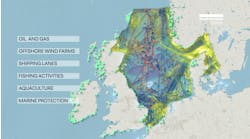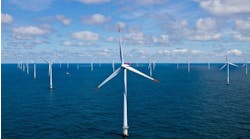Report highlights impact on bats of Baltic Sea wind farm
Offshore staff
COPENHAGEN, Denmark — Consultancy WSP has prepared a report on bat movements around the Kriegers Flak wind farm in the Danish sector of the Baltic Sea for the Danish Energy Agency (DEA).
The findings will support how the DEA manages the Habitats Directive's protection of bats in connection with permits for offshore wind turbines.
Little is known about bats at sea, but taking consideration of their presence will become mandatory under the EU's Habitats Directive as offshore wind farms accelerates toward 2030 and beyond.
The report identified many sightings of bats far from the coast at Kriegers Flak, with four bat species registered in the area over a two-year period. About 90% of the registrations were at wind speeds below 6 m/s.
Some species, however, such as troll bats, have been noted at higher speeds of up to 7 m/s or more. Temperature is also a factor: some species not present below 17°C, while others appear down to 13°C.
The report also confirms migrations of bats in spring and during the fall between Western Europe and Scandinavia, with some scouring the area to search for food.
The DEA will submit WSP's report to the Danish Environmental Protection Agency for use in any updates of the Danish Centre for Environment and Energy’s "Handbook on animal species on Annex IV, Part 2 – Otters and bats" of April 2024.
In addition, the agency is developing a fixed practice for determining remedial measures to protect bats in connection with the establishment of offshore wind farms.
Traditionally this has been addressed through the use of cut-in-speed, which involves reducing the rotation of wind turbines at certain times of the year or day to limit the risk of killing bats.
The DEA and WSP are also collaborating with developer Vattenfall to map bat occurrences in the Kattegat region under a program due to be completed by the end of the year.
In addition, significant amounts of new bat data are emerging via current studies in the Baltic Sea, inner Danish waters and in the North Sea. These are connected to the 6-GW tender and study data for Denmark’s Energy Islands.
WSP has also prepared a report for the DEA on the presence of sea water at Kriegers Flak. Observations suggest oystercatchers will continue to use the area after the offshore wind farm has been completed and that the birds will move between the wind turbines.
06.25.2024



